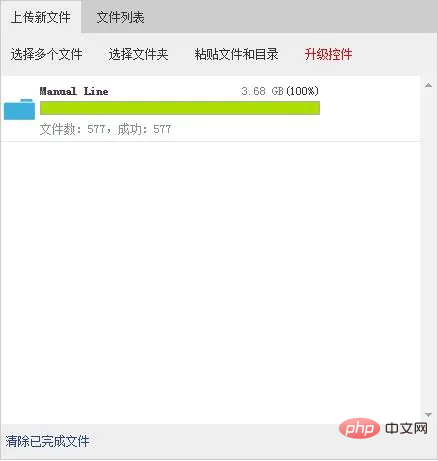How to implement multi-part file upload in PHP
Jan 17, 2020 pm 05:35 PM
PHP uses the super global variable array $_FILES to record file upload related information.
1.file_uploads=on/off
Whether it is allowed to upload files via http
2.max_execution_time=30
The maximum script execution time is allowed. If this time is exceeded, an error will be reported.
3.memory_limit=50M
Set the script to be allocated The maximum amount of memory to prevent runaway scripts from occupying too much memory. This directive can only be set at compile time.
--It only takes effect when the enable-memory-limit flag is set
4.upload_max_filesize=20M
The maximum size of files allowed to be uploaded, this The command must be smaller than post_max_size
5.upload_tmp_dir
Temporary storage directory for uploaded files
6.post_max_size=30M
Allow the post mode to accept the maximum size
$_FILES['myFile']['name'] The original name of the client's last file.
$_FILES['myFile']['type'] The MIME type of the file, which requires the browser to provide support for this information, such as "image/gif".
$_FILES['myFile']['size'] The size of the uploaded file, in bytes.
$_FILES['myFile']['tmp_name'] The temporary file name stored on the server after the file is uploaded, usually the system default. It can be specified in upload_tmp_dir in php.ini, but setting it with the putenv() function has no effect.
$_FILES['myFile']['error'] Status code related to the file upload. ['error'] was added in PHP 4.2.0. The following is its description: (They became constants after PHP3.0)
UPLOAD_ERR_OK
Value: 0; No error occurred and the file was uploaded successfully.
UPLOAD_ERR_INI_SIZE
Value: 1; The uploaded file exceeds the value limited by the upload_max_filesize option in php.ini.
UPLOAD_ERR_FORM_SIZE
Value: 2; The size of the uploaded file exceeds the value specified by the MAX_FILE_SIZE option in the HTML form.
UPLOAD_ERR_PARTIAL
Value: 3; Only part of the file was uploaded.
UPLOAD_ERR_NO_FILE
Value: 4; No file was uploaded.
Value: 5; The uploaded file size is 0.
After the file is uploaded, it is stored in the temporary directory by default. At this time, you must delete it from the temporary directory or Move it somewhere else, or if it doesn't exist, it will be deleted.
That is, regardless of whether the upload is successful or not, the files in the temporary directory will definitely be deleted after the script is executed.
Attachment: How to modify the size limit of PHP upload files
1. General file upload, unless the file is very small. Like a 5M file, it will probably take more than a minute to upload.
But in php, the default maximum execution time of the page is 30 seconds. That is to say, if it exceeds 30 seconds, the script will stop executing.
This results in the failure to open For the situation of the web page, we can modify max_execution_time
Look for
max_execution_time
in php.ini. The default is 30 seconds. Change to
max_execution_time = 0
0 means no limit
2. Modify post_max_size to set the maximum size allowed for POST data. This setting also affects file uploads.
The default post_max_size of php is 2M. If the POST data size is larger than post_max_size, $_POST and $_FILES superglobals will be empty.
Find post_max_size. Change to
post_max_size = 150M
3. Many people will change the second step, but the maximum size when uploading files is still 8M.
Why? We also need to change a parameter upload_max_filesize to indicate the maximum size of the uploaded file.
Look for upload_max_filesize, the default is 8M and change it to
upload_max_filesize = 100M
In addition, it should be noted that post_max_size is better than upload_max_filesize.
Upload effect display :

PHP Chinese website has a large number of free PHP video tutorials, everyone is welcome to learn!
This article is reproduced from: https://www.jianshu.com/p/6460dc947209

Hot AI Tools

Undress AI Tool
Undress images for free

Undresser.AI Undress
AI-powered app for creating realistic nude photos

AI Clothes Remover
Online AI tool for removing clothes from photos.

Clothoff.io
AI clothes remover

Video Face Swap
Swap faces in any video effortlessly with our completely free AI face swap tool!

Hot Article

Hot Tools

Notepad++7.3.1
Easy-to-use and free code editor

SublimeText3 Chinese version
Chinese version, very easy to use

Zend Studio 13.0.1
Powerful PHP integrated development environment

Dreamweaver CS6
Visual web development tools

SublimeText3 Mac version
God-level code editing software (SublimeText3)
 How to use PHP to build social sharing functions PHP sharing interface integration practice
Jul 25, 2025 pm 08:51 PM
How to use PHP to build social sharing functions PHP sharing interface integration practice
Jul 25, 2025 pm 08:51 PM
The core method of building social sharing functions in PHP is to dynamically generate sharing links that meet the requirements of each platform. 1. First get the current page or specified URL and article information; 2. Use urlencode to encode the parameters; 3. Splice and generate sharing links according to the protocols of each platform; 4. Display links on the front end for users to click and share; 5. Dynamically generate OG tags on the page to optimize sharing content display; 6. Be sure to escape user input to prevent XSS attacks. This method does not require complex authentication, has low maintenance costs, and is suitable for most content sharing needs.
 How to use PHP combined with AI to achieve text error correction PHP syntax detection and optimization
Jul 25, 2025 pm 08:57 PM
How to use PHP combined with AI to achieve text error correction PHP syntax detection and optimization
Jul 25, 2025 pm 08:57 PM
To realize text error correction and syntax optimization with AI, you need to follow the following steps: 1. Select a suitable AI model or API, such as Baidu, Tencent API or open source NLP library; 2. Call the API through PHP's curl or Guzzle and process the return results; 3. Display error correction information in the application and allow users to choose whether to adopt it; 4. Use php-l and PHP_CodeSniffer for syntax detection and code optimization; 5. Continuously collect feedback and update the model or rules to improve the effect. When choosing AIAPI, focus on evaluating accuracy, response speed, price and support for PHP. Code optimization should follow PSR specifications, use cache reasonably, avoid circular queries, review code regularly, and use X
 PHP calls AI intelligent voice assistant PHP voice interaction system construction
Jul 25, 2025 pm 08:45 PM
PHP calls AI intelligent voice assistant PHP voice interaction system construction
Jul 25, 2025 pm 08:45 PM
User voice input is captured and sent to the PHP backend through the MediaRecorder API of the front-end JavaScript; 2. PHP saves the audio as a temporary file and calls STTAPI (such as Google or Baidu voice recognition) to convert it into text; 3. PHP sends the text to an AI service (such as OpenAIGPT) to obtain intelligent reply; 4. PHP then calls TTSAPI (such as Baidu or Google voice synthesis) to convert the reply to a voice file; 5. PHP streams the voice file back to the front-end to play, completing interaction. The entire process is dominated by PHP to ensure seamless connection between all links.
 PHP creates a blog comment system to monetize PHP comment review and anti-brush strategy
Jul 25, 2025 pm 08:27 PM
PHP creates a blog comment system to monetize PHP comment review and anti-brush strategy
Jul 25, 2025 pm 08:27 PM
1. Maximizing the commercial value of the comment system requires combining native advertising precise delivery, user paid value-added services (such as uploading pictures, top-up comments), influence incentive mechanism based on comment quality, and compliance anonymous data insight monetization; 2. The audit strategy should adopt a combination of pre-audit dynamic keyword filtering and user reporting mechanisms, supplemented by comment quality rating to achieve content hierarchical exposure; 3. Anti-brushing requires the construction of multi-layer defense: reCAPTCHAv3 sensorless verification, Honeypot honeypot field recognition robot, IP and timestamp frequency limit prevents watering, and content pattern recognition marks suspicious comments, and continuously iterate to deal with attacks.
 PHP realizes commodity inventory management and monetization PHP inventory synchronization and alarm mechanism
Jul 25, 2025 pm 08:30 PM
PHP realizes commodity inventory management and monetization PHP inventory synchronization and alarm mechanism
Jul 25, 2025 pm 08:30 PM
PHP ensures inventory deduction atomicity through database transactions and FORUPDATE row locks to prevent high concurrent overselling; 2. Multi-platform inventory consistency depends on centralized management and event-driven synchronization, combining API/Webhook notifications and message queues to ensure reliable data transmission; 3. The alarm mechanism should set low inventory, zero/negative inventory, unsalable sales, replenishment cycles and abnormal fluctuations strategies in different scenarios, and select DingTalk, SMS or Email Responsible Persons according to the urgency, and the alarm information must be complete and clear to achieve business adaptation and rapid response.
 How to use PHP to combine AI to generate image. PHP automatically generates art works
Jul 25, 2025 pm 07:21 PM
How to use PHP to combine AI to generate image. PHP automatically generates art works
Jul 25, 2025 pm 07:21 PM
PHP does not directly perform AI image processing, but integrates through APIs, because it is good at web development rather than computing-intensive tasks. API integration can achieve professional division of labor, reduce costs, and improve efficiency; 2. Integrating key technologies include using Guzzle or cURL to send HTTP requests, JSON data encoding and decoding, API key security authentication, asynchronous queue processing time-consuming tasks, robust error handling and retry mechanism, image storage and display; 3. Common challenges include API cost out of control, uncontrollable generation results, poor user experience, security risks and difficult data management. The response strategies are setting user quotas and caches, providing propt guidance and multi-picture selection, asynchronous notifications and progress prompts, key environment variable storage and content audit, and cloud storage.
 Beyond the LAMP Stack: PHP's Role in Modern Enterprise Architecture
Jul 27, 2025 am 04:31 AM
Beyond the LAMP Stack: PHP's Role in Modern Enterprise Architecture
Jul 27, 2025 am 04:31 AM
PHPisstillrelevantinmodernenterpriseenvironments.1.ModernPHP(7.xand8.x)offersperformancegains,stricttyping,JITcompilation,andmodernsyntax,makingitsuitableforlarge-scaleapplications.2.PHPintegrateseffectivelyinhybridarchitectures,servingasanAPIgateway
 PHP integrated AI speech recognition and translator PHP meeting record automatic generation solution
Jul 25, 2025 pm 07:06 PM
PHP integrated AI speech recognition and translator PHP meeting record automatic generation solution
Jul 25, 2025 pm 07:06 PM
Select the appropriate AI voice recognition service and integrate PHPSDK; 2. Use PHP to call ffmpeg to convert recordings into API-required formats (such as wav); 3. Upload files to cloud storage and call API asynchronous recognition; 4. Analyze JSON results and organize text using NLP technology; 5. Generate Word or Markdown documents to complete the automation of meeting records. The entire process needs to ensure data encryption, access control and compliance to ensure privacy and security.





